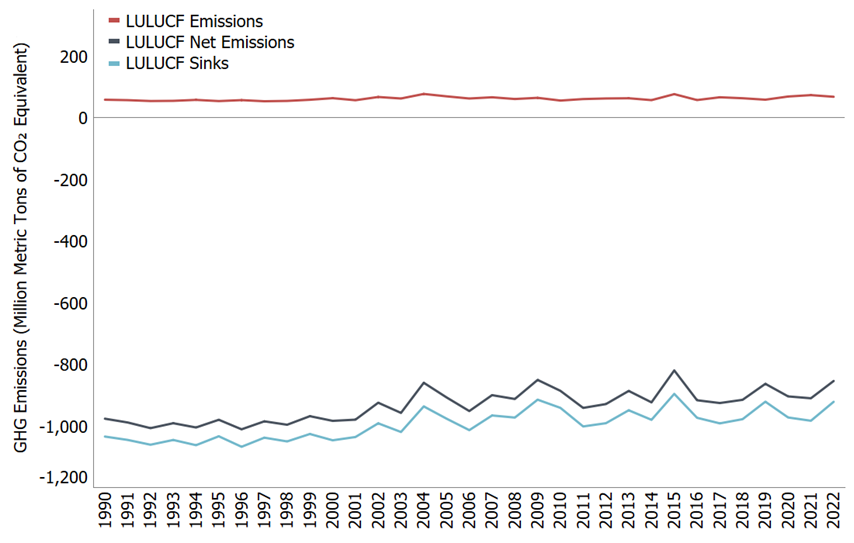Land Use, Land-Use Change, and Forestry Sector Emissions and Sequestration
On this page:
- Land Use, Land-Use Change, and Forestry: A Carbon “Sink”
- Emissions and Trends
- Reducing Emissions and Enhancing Sinks from Land Use, Land-Use Change, and Forestry
Land Use, Land-Use Change, and Forestry: A Carbon “Sink”
Plants absorb carbon dioxide (CO2) from the atmosphere as they grow, and they store some of this carbon as perennial aboveground and belowground biomass throughout their lifetime. Soils and dead organic matter/litter can also store some of the carbon from these plants depending on how the soil is managed and other environmental conditions (e.g., climate). This storage of carbon in plants, dead organic matter/litter and soils is called biological carbon sequestration. Because biological sequestration takes CO2 out of the atmosphere and stores it in these carbon pools, it is also called a carbon "sink."
Emissions or sequestration of CO2, as well as emissions of CH4 and N2O, can occur from management of lands in their current use or as lands are converted to other land uses. Carbon dioxide is exchanged between the atmosphere and the plants and soils on land, for example, as cropland is converted into grassland, as lands are cultivated for crops, or as forests grow. In addition, using biological feedstocks (such as energy crops or wood) for purposes such as electricity generation, as inputs to processes that create liquid fuels, or as building materials can lead to emissions or sequestration.*
In the United States overall, Land Use, Land-Use Change, and Forestry (LULUCF) activities have resulted in more removal of CO2 from the atmosphere than emissions. Because of this, the LULUCF sector in the United States is considered a net sink, rather than a source, of CO2. In many areas of the world, the opposite is true, particularly in countries where large areas of forest land are cleared, often for conversion to agricultural purposes or for settlements. In these situations, the LULUCF sector can be a net source of greenhouse gas emissions.
- More national-level information about land use, land-use change, and forestry is available from the Land Use, Land-Use Change, and Forestry chapter in the Inventory of U.S. Greenhouse Gas Emissions and Sinks. For more information on emissions and sequestration from forest land and urban trees in settlement areas, see also the USDA's USFS Resource Bulletin.
- For more information about global emissions from land use and forestry activities, see EPA's Global Greenhouse Gas emissions page and the Contribution of Working Group III to the Fifth Assessment Report of the Intergovernmental Panel on Climate Change.
* Emissions and sequestration of CO2 are presented under the Land Use, Land-Use Change, and Forestry sector in the Inventory. Other emissions from CH4, and N2O are also presented in the Energy sector (pdf).
Emissions and Trends
- In 2022, the net CO2 removed from the atmosphere from the LULUCF sector was 13% of total U.S. greenhouse gas emissions.
- Between 1990 and 2022, total carbon sequestration in the LULUCF sector decreased by 11%, primarily due to a decrease in the rate of net carbon accumulation in forests, as well as an increase in CO2 emissions from urbanization. Additionally, while episodic in nature, increased CO2, CH4 and N2O emissions from forest fires have also occurred over the time series.
Reducing Emissions and Enhancing Sinks from Land Use, Land-Use Change, and Forestry
In the LULUCF sector, opportunities exist to reduce greenhouse gas emissions and increase the potential to sequester carbon from the atmosphere by enhancing sinks. The table shown below provides some examples of opportunities for both reducing emissions and enhancing sinks. For a more comprehensive list, see Chapter 7 of the Contribution of Working Group III to the Sixth Assessment Report of the Intergovernmental Panel on Climate Change.
| Type | How Emissions Are Reduced or Sinks Are Enhanced | Examples |
|---|---|---|
| Change in Uses of Land | Increasing carbon storage by using land differently or maintaining carbon storage by avoiding land degradation. |
|
| Changes in Land Management Practices | Improving management practices on existing land-use types. |
|

